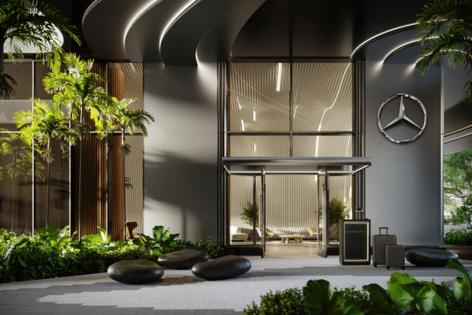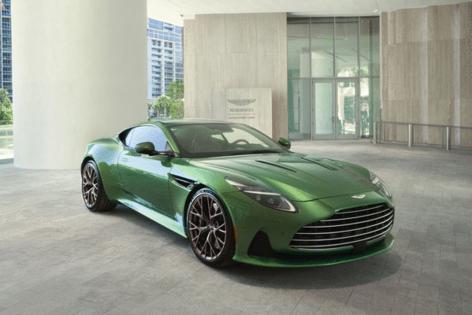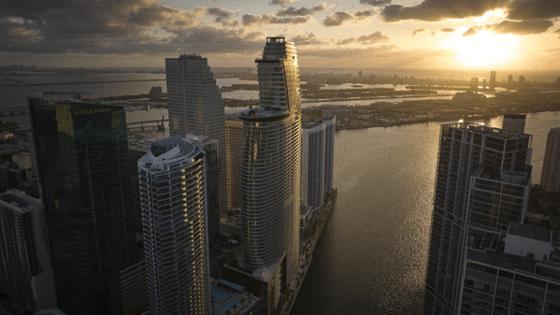Automakers are revved up over condominium towers
Published in Automotive News
MIAMI — It’s the hottest trend in the automotive industry, and it’s not electric vehicles or autonomous driving. It’s something far more prosaic and unlikely: the automotive-branded high-rise condominium tower.
It started with the Porsche Design Tower, which opened in 2017. The Bentley Residences followed in 2022, a 749-foot high, 60-story condominium, still being built at a cost of $850 million. Both car brands are owned by the Volkswagen Group and constructed by Dezer Development, which also co-developed the Trump Grande, the Trump Towers, and the Residences by Armani/Casa, all in Sunny Isles Beach, Florida, north of Miami Beach. Uniquely, vehicle elevators are used in both the Porsche and Bentley buildings, allowing condo owners to park in their own private multi-car, glass-walled garage next to their apartment.
Other automakers are finally following their lead.
In February, German automaker Mercedes-Benz announced Mercedes-Benz Places, a 791-unit, 67-story mixed-use residential tower located in Miami’s Brickell neighborhood. Built in partnership with JDS Development Group, headquartered in Manhattan and Miami, further details of the project were revealed Wednesday night. Units range in size from studios to three-bedrooms. Plans call for the tower to incorporate 200,000 square feet of shops, offices, health and fitness centers, and a 174-key Treehouse Hotel. Redevelopment of Southside Park and a neighboring Miami fire station are also part of the plans.
It was followed in March by supercar maker Pagani, revealing plans for the Pagani Residences, to be located in North Bay Village near Miami. The 28-story condo tower will have four units per floor, allowing all to be corner units, ranging in size from 2,000 to more than 3,300 square-feet, as well as a 6,900-square-foot penthouse with 4,400 square feet of outdoor space.
But the latest tower to reach completion are the Aston Martin Residences, a 66-story, 391-unit tower also in the Brickell section of Miami. Ninety-nine percent of the units are sold, ranging in size from a $820,000, 698-square-foot, single-bath studio to a 27,191-square-foot, $59 million, seven-bedroom, eight-bathroom, three-level penthouse. Among the amenities: a new Aston Martin Vulcan and 7,323 square feet of private outdoor space with its own pool and spa. But some buyers don’t need the car, as more than 50 residents already own one.
Both Aston Martin and Mercedes-Benz hosted events Wednesday night ahead of this weekend’s Formula One race in Miami, its spectators being an affluent and receptive audience for both brands.
To visit the Aston Martin Residences, the brand’s first real estate project, is to experience the sort of apartment building once common for the middle class but now reserved only for the wealthy. My grandmother’s middle-class apartment building in Philadelphia boasted its own food market, beauty salon, flower shop, medical offices, dining room, bar, outdoor swimming pool with cabanas, private gardens and parking garage.
Aston Martin Residences has many of the same amenities, including hair salons, a two-story gym, spa, ballroom, children’s’ rec rooms, rooftop pool with cabana and DJ booth, not to mention a private art gallery, movie theaters and golf simulator. And while it’s easy to come away impressed, you might find it harder to see how it relates to Aston Martin.
But there are similarities in aesthetic and design approach, according to Marek Reichman, Aston Martin’s chief creative officer, who guided the design over its decade-long gestation.
“It's an application of what I would call a design DNA onto a different vernacular. From a Valkyrie to a DBX SUV is a quantum change, but they both got four wheels. But their capabilities are highly different, and they have that red thread of DNA running through them,” Reichman said. “It's then taking that DNA and applying it to a building, which is fundamentally different, but in many respects the same because you've got to honor the design belief and the design ethos of Aston Martin.”
For Reichman, that means a timeless design, one that immediately becomes iconic. This might explain the building’s bowed appearance, with a form recalling an airfoil, or perhaps a sail being blown by the wind. Its rounded shape, which he first doodled on a napkin while consulting with the tower’s architects, works perfectly on the tower’s windswept spit of land on Miami’s Brickell Point. Step inside, and you’re greeted by acres of book-matched marble and other similarly opulent finishes. But the design similarities to the brand’s cars are far more nuanced and contemporary, yet ageless.
“We're designing cars that will exist in people's collections forever. You'd you don't throw an Aston Martin away; 96% of the cars we've ever made since 1913 still exist," Reichman said. "We're building homes with a certain aesthetic and even if it's your second, third, or fourth home where you live, it represents you just as what you drive. We had to ensure that all the values that exist within that 117-year-old brand existed in this brand-new building today.”
That said, automaker residences also make for a great passive marketing tool, and help extend an automobile’s aura beyond vehicles, not only into architecture, but into furniture or clothing or accessories. Importantly, they also yield steady licensing income, helping insulate manufacturers from the fickle new car market.
But Aston Martin Residence owners yield the biggest benefit; living with that certain Aston Martin je ne sais quoi 24/7.
“It's so imposing, but it's not overloading,” Reichman said. “it's just right because it's an Aston Martin, and that's what makes it an Aston Martin.”
©2024 Tribune Content Agency, LLC












Comments